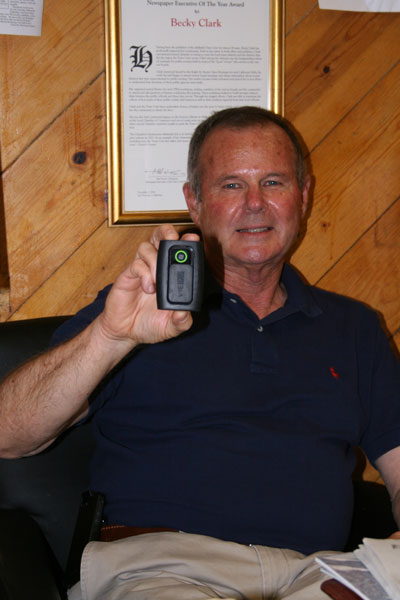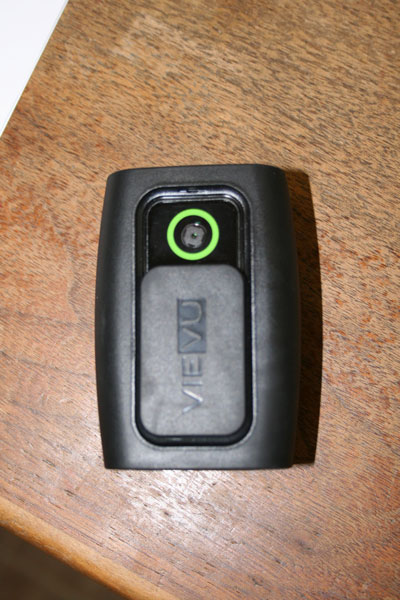
Photos by Becky Clark
Riverside County Sheriff Stan Sniff met with the editorial and reporting staff of the Idyllwild Town Crier last week.
One of the first topics discussed was Sniff’s recent decision to expand the use of body worn cameras. Currently deputies in the Jurupa Valley Sheriff’s Station have been testing the use of the cameras on a voluntary basis. Nearly 150 members of the Sheriff’s staffing, including deputies, corporals, investigators, sergeants and community service officers participated in the test.
On June 12, Sniff decided the results demonstrated and established the value of the cameras for the entire department. Before a full implementation, the County’s Human Relations staff will meet and confer with the Riverside County Sheriff’s Association about the program, but Sniff is confident that the future will see all deputies, and possibly detectives, wearing the cameras.
In his press release announcing the decision to expand the camera’s use, he said, “The Sheriff’s Department has notified County Human Resources that the decision on ‘mandatory’ use in patrol operations has been made and the County remains open to meeting and conferring with the various labor groups on any foreseeable workplace impacts of that management decision.”

Deputies will have discretion to turn them off, Sniff said. “We’ll leave it to the officers, but they’re a good defensive mechanism if a complaint is filed against the officer.”
Another important reason for his decision was the decline in citizen complaints at the Jurupa Station. Since the test began in March, the number of complaints has fallen nearly 30 percent.
Another contributing reason is most deputies wanted the video. In the past, it was common for deputies to purchase their own personal tape recorders in order to have a record of what happened during many incidents. The body cameras, which attach to the shirt, will provide capture more of the action.
However, they do have limitations, such as a narrow field of focus, rapid movement can create blurred images, and can easily be knocked off. Sniff said, “They’re not a panacea. But they are a useful tool to help us.” Nevertheless, the video is valuable and can capture more information than a human might be aware of during a high-stress moment.
According to Sniff, one of the issues that will be discussed with the RSA is the availability of the video to officers before they write a report involving a major incident, such as an officer involved shooting. Sniff wants the priority to emphasize the Department’s credibility with citizens, the press and in court.
The cameras initially cost almost $1,100 each, but prices have fallen to between $700 and $800. The full cost to outfit 1,000 deputies will be about $1.25 million. On June 15, the Sheriff’s Department submitted a request to U.S. Department of Justice for $625,000 to help offset the cost, which also includes equipment to store all of the video. If approved, the County will match the federal grant.
Regarding the board’s recent budget decision to set the ratio of deputies per 1,000 residents in the unincorporated areas at 1.04, Sniff was confident this was a temporary decision. Next year, the board will return to its goal of 1.2 deputies. He stressed that the number of deputies to meet these levels is spread over 10 stations and significantly less than the staffing levels to operate the expanded and new jail facilities.
Sniff also discussed the Board of Supervisor’s recent decision to seek an independent audit of the Sheriff’s, District Attorney’s and Probation Department’s budgets.
The Sheriff’s Department contracts to provide police services to 17 cities and the Morongo Indian Reservation. The recent escalation in the contract costs due to these mandated salary increases has resulted in several cities appealing and complaining to the board.
While he acknowledges that costs continue to grow faster than county revenues, Sniff avows this not attributable to new or out-of-control programs in his department.
The board and the employee associations agreed to significant salary increases over the past several years and into the future as a trade-off for concessions on pension costs. Sniff stressed that he does not negotiate the memoranda of understanding with the various employee associations. That is the County Chief Executive Officer’s staff responsibility.
“These increases are almost entirely due to pay raises,” he stated. “For contract cities, payroll is typically 90 percent of their costs.”
Since 2008, total compensation for a county deputy sheriff has increased nearly 31 percent. Since 2009, salaries alone have grown nearly 25 percent.
Besides the renegotiations of the employee contracts, the board decided to expand the Indio jail and is building a new facility, the East County Detention Center, which will require hundreds of new deputies and other staff to operate.
“The state sets the requirements for jails,” he said.
While Sniff will work with the contractor, he is unclear what the final product will contribute to the debate. He has little flexibility or responsibility for setting salaries or jail staffing levels.
Sniff has been the county sheriff since October 2007. He was appointed to fill the term of former Sheriff Bob Doyle. The Sheriff is elected countywide and Sniff was elected to his own four-year terms in 2010 and 2014.










